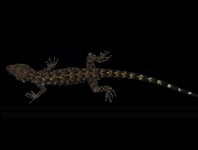Abstract
We describe a new species of Cyrtodactylus from Guwahati city in the state of Assam, India and provide additional data on the recently described Cyrtodactylus guwahatiensis. Cyrtodactylus urbanus sp. nov. falls in the newly defined khasiensis group within the Indo-Burma clade of Cyrtodactylus and is the poorly supported sister taxon to Cyrtodactylus khasiensis. The new species differs from other members of the khasiensis group in mitochondrial sequence data (12.5–17.1 % uncorrected pairwise ND2 sequence divergence) as well as aspects of morphology including the number and arrangement of precloacal pores in males, the number of mid-ventral scales and paravertebral tubercles, and colour pattern. This is the second Cyrtodactylus endemic to the Guwahati region, the fourth from Assam and the twelfth from Northeast India.
References
Agarwal, I., Bauer, A.M., Jackman, T.R. & Karanth, K.P. (2014) Insights into Himalayan biogeography from geckos: A molecular phylogeny of Cyrtodactylus (Squamata: Gekkonidae). Molecular Phylogenetics and Evolution, 80, 145–155.
https://doi.org/10.1016/j.ympev.2014.07.018
Agarwal, I. & Karanth, K.P. (2015) A phylogeny of the only ground-dwelling radiation of Cyrtodactylus (Squamata, Gekkonidae): diversification of Geckoella across peninsular India and Sri Lanka. Molecular Phylogenetics and Evolution, 82, 193–199.
https://doi.org/10.1016/j.ympev.2014.09.016
Agarwal, I., Khandekar, A. & Bauer, A.M. (2018a) A new bent-toed gecko (Squamata: Gekkonidae) from the Western Himalayas, Himachal Pradesh, India. Zootaxa, 4446 (4), 442–454.
https://doi.org/10.11646/zootaxa.4446.4.2
Agarwal, I., Mahony, S., Giri, V.B., Chaitanya, R. & Bauer, A.M. (2018b) Two new species of Cyrtodactylus Gray, 1827 (Squamata: Gekkonidae) with comments on name-bearing types from northeast India. Zootaxa, 4420 (3), 334–356.
https://doi.org/10.11646/zootaxa.4420.3.2
Agarwal, I., Mahony, S., Giri, V.B., Chaitanya, R. & Bauer, A.M. (2018c) Six new Cyrtodactylus (Squamata: Gekkonidae) from northeast India. Zootaxa, 4524 (5), 501–535.
https://doi.org/10.11646/zootaxa.4524.5.1
Bauer, A.M. (2002) Two new species of Cyrtodactylus (Squamata: Gekkonidae) from Myanmar. Proceedings of the California Academy of Sciences, 53, 73–86.
Bauer, A.M. (2003) Descriptions of seven new Cyrtodactylus (Squamata: Gekkonidae) with a key to the species of Myanmar (Burma). Proceedings of the California Academy of Sciences, 54, 463–498
Datta-Roy, A., Das, I., Bauer, A.M., Tron, R.K.L. & Karanth, P. (2013) Lizard wears shades. A spectacled Sphenomorphus (Squamata: Scincidae), from the sacred forests of Mawphlang, Meghalaya, North-east India. Zootaxa, 3701 (2), 257–276.
https://doi.org/10.11646/zootaxa.3701.2.7
Grismer, L.L., Wood, P.L., Thura, M.K., Zin, T., Quah, E.S., Murdoch, M.L., Grismer, M.S., Lin, A., Kyaw, H. & Ngwe, L. (2018a) Twelve new species of Cyrtodactylus Gray (Squamata: Gekkonidae) from isolated limestone habitats in east-central and southern Myanmar demonstrate high localized diversity and unprecedented microendemism. Zoological Journal of the Linnean Society, 182, 862–959.
https://doi.org/10.1093/zoolinnean/zlx057
Grismer, L.L., Wood Junior, P.L., Quah, E.S.H., Murdoch, M.L., Grismer, M.S., Herr, M.W. & Lin, A. (2018b) A phylogenetic taxonomy of the Cyrtodactylus peguensis group (Reptilia: Squamata: Gekkonidae) with descriptions of two new species from Myanmar. PeerJ, 6, e5575.
https://doi.org/10.7717/peerj.5575
Grismer, L.L., Wood Jr, P.L., Thura, M.K., Quah, E.S., Murdoch, M.L., Grismer, M.S., Herr, M.W., Lin, A. & Kyaw, H. (2018c) Three more new species of Cyrtodactylus (Squamata: Gekkonidae) from the Salween Basin of eastern Myanmar underscore the urgent need for the conservation of karst habitats. Journal of Natural History, 52, 1243–1294.
https://doi.org/10.1080/00222933.2018.1449911
Kamei, R.G., Mauro, D.S., David, D.J., Bocxlaer, I.V., Sherratt, E., Thomas, A., Babu, S., Bossuyt, F., Wilkinson, M. & Biju, S.D. (2012) Discovery of a new family of amphibians from northeast India with ancient links to Africa. Proceedings of the Royal Society B, 279, 2396–2401.
http://doi.org/10.1098/rspb.2012.0150
Legler, J.M. & Sullivan, L.J. (1979) The application of stomach-flushing to lizards and anurans. Herpetologica, 35, 1979, 107–110.
Macey, J.R., Larson, A., Ananjeva, N.B., Fang, Z. & Papenfuss, T.J. (1997) Two novel gene orders and the role of light-strand replication in rearrangement of the vertebrate mitochondrial genome. Molecular Biology and Evolution, 14, 91–104.
https://doi.org/10.1093/oxfordjournals.molbev.a025706
Mahony, S. (2009b) Taxonomic status of Cyrtodactylus khasiensis tamaiensis (Smith, 1940) and description of a new species allied to C. chrysopylos Bauer, 2003 from Myanmar (Reptilia: Gekkonidae). Hamadryad, 34, 62–74.
Purkayastha, J. (2018) Urban biodiversity: an insight into the terrestrial vertebrate diversity of Guwahati, India. Journal of Threatened Taxa, 10, 12299–12316.
https://doi.org/10.11609/jott.3721.10.10.12299-12316
Purkayastha, J. & David, P. (2019) A new species of the snake genus Hebius Thompson from Northeast India (Squamata: Natricidae). Zootaxa, 4555 (1), 79–90.
https://doi.org/10.11646/zootaxa.4555.1.6
Silvestro, D. & Michalak, I. (2012) RaxmlGUI: A graphical front-end for RAxML. Organisms Diversity and Evolution, 12, 335–337.
https://doi.org/10.1007/s13127-011-0056-0
Tamura, K., Peterson, D., Peterson, N., Stecher, G., Nei, M. & Kumar, S. (2011) MEGA5: Molecular Evolutionary Genetics Analysis using maximum likelihood, evolutionary distance, and maximum parsimony methods. Molecular Biology and Evolution, 28, 2731–2739.
https://doi.org/10.1093/molbev/msr121
Stamatakis, A. (2006) RAxML-VI-HPC: maximum likelihood-based phylogenetic analyses with thousands of taxa and mixed models. Bioinformatics, 22, 2688–2690.
https://doi.org/10.1093/bioinformatics/btl446
Uetz, P., Freed, P. & Hošek, J. (Eds.) (2019) The Reptile Database. Available from: http://www.reptile-database.org (accessed 16 September 2019)

